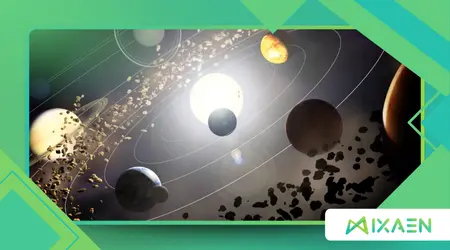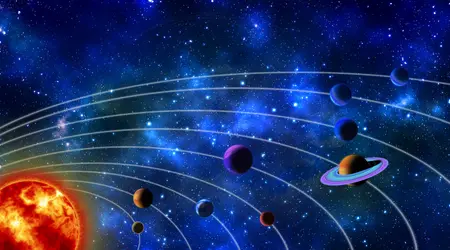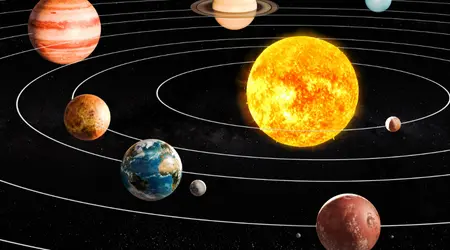Formation of the Solar System: From Nebula to Current Structure

The Formation of the Solar System is one of the most captivating stories in astronomy, a tale of cosmic dust, gravity, and time.
Anúncios
Around 4.6 billion years ago, a swirling cloud of gas and dust—known as the solar nebula—collapsed under its own gravity, setting the stage for the birth of our Sun and its planetary entourage.
This process, governed by the laws of physics, shaped the intricate architecture we observe today.
But how did this chaotic cloud transform into the orderly system we call home?
Let’s dive into the science behind this extraordinary journey.
The Solar Nebula: A Chaotic Beginning
The story begins with a massive molecular cloud, a region of space filled with hydrogen, helium, and trace amounts of heavier elements.
According to the widely accepted nebular hypothesis, a nearby supernova explosion or a passing star’s gravitational pull triggered the collapse of this cloud.
As it contracted, the cloud began to spin faster, flattening into a rotating disk.
At the center, the densest region accumulated most of the mass, eventually igniting nuclear fusion and giving birth to the Sun.
Meanwhile, the surrounding disk of gas and dust began to clump together, forming planetesimals—the building blocks of planets.
This phase of the Formation of the Solar System was marked by intense heat and frequent collisions, a chaotic environment where only the strongest structures survived.
+ The Biggest Asteroid Impacts on the Solar System: Discover the Giant Craters
The Birth of Planets: Differentiation and Dynamics
As the Sun shone brightly, the remaining material in the disk began to cool.
Close to the Sun, where temperatures were higher, only metals and silicates could solidify, leading to the formation of rocky planets like Mercury, Venus, Earth, and Mars.
Farther out, where it was colder, volatile compounds like water, methane, and ammonia could condense, giving rise to the gas giants—Jupiter and Saturn—and the ice giants—Uranus and Neptune.
This process, known as planetary differentiation, also explains why the inner and outer planets have such distinct compositions.
For instance, Jupiter’s massive gravity prevented the formation of another large planet in its vicinity, scattering debris and influencing the Formation of the Solar System’s current structure.
The Role of Asteroids and Comets
Asteroids and comets are often called the “leftovers” of the Formation of the Solar System, but they played a crucial role in shaping its evolution.
The asteroid belt, located between Mars and Jupiter, is a relic of the early solar system, containing remnants that never coalesced into a planet.
Comets, on the other hand, originate from the Kuiper Belt and the distant Oort Cloud, carrying pristine material from the system’s infancy.
These celestial bodies are more than just debris; they are time capsules.
For example, the study of meteorites—fragments of asteroids that fall to Earth—has revealed clues about the age and composition of the early solar system.
A 2021 study published in Science analyzed isotopes in meteorites and confirmed that the solar system’s formation occurred within a remarkably short timeframe of about 10 million years.

The Late Heavy Bombardment: A Violent Adolescence
Around 4 billion years ago, the solar system experienced a period of intense bombardment known as the Late Heavy Bombardment (LHB).
During this time, a surge of asteroids and comets pummeled the inner planets, leaving behind craters that are still visible on the Moon and Mercury.
One leading theory suggests that the LHB was caused by the migration of Jupiter and Saturn, whose gravitational influence destabilized the orbits of smaller bodies.
This chaotic period not only shaped the surfaces of planets but also delivered water and organic molecules to Earth, potentially seeding the ingredients for life.
The Solar System Today: A Dynamic Equilibrium
Today, the solar system is a dynamic but stable environment.
The planets orbit the Sun in nearly circular paths, held in place by gravity. However, this equilibrium is not static.
For instance, the Sun’s gradual loss of mass causes the planets to slowly drift outward.
Additionally, gravitational interactions between celestial bodies can lead to subtle changes in orbits over millions of years.
The Formation of the Solar System also left behind a wealth of smaller objects, from dwarf planets like Pluto to countless moons, rings, and dust particles.
Each of these components offers a glimpse into the processes that shaped our cosmic neighborhood.
Tables: Key Stages and Characteristics of Solar System Formation
| Stage | Description | Timeframe |
|---|---|---|
| Solar Nebula Collapse | A molecular cloud collapses under gravity, forming a rotating disk. | ~4.6 billion years ago |
| Sun Formation | The central region ignites nuclear fusion, becoming the Sun. | ~4.59 billion years ago |
| Planetesimal Formation | Dust and gas clump together, forming planetesimals. | ~4.58 billion years ago |
| Planetary Differentiation | Rocky planets form near the Sun; gas and ice giants form farther out. | ~4.57 billion years ago |
| Late Heavy Bombardment | A surge of impacts reshapes the inner planets. | ~4 billion years ago |
++ The Origin of the Kuiper Belt: Exploring the Edge of the Solar System
| Region | Characteristics | Key Bodies |
|---|---|---|
| Inner Solar System | Rocky planets, high temperatures, metal-rich composition. | Mercury, Venus, Earth, Mars |
| Asteroid Belt | Remnants of planet formation, diverse composition. | Ceres, Vesta, Pallas |
| Outer Solar System | Gas and ice giants, cold temperatures, volatile-rich composition. | Jupiter, Saturn, Uranus, Neptune |
| Kuiper Belt & Oort Cloud | Source of comets, icy bodies, and dwarf planets. | Pluto, Eris, Sedna |

The Future of the Solar System
While the Formation of the Solar System is a story of the past, its future is equally fascinating.
In about 5 billion years, the Sun will exhaust its hydrogen fuel, expanding into a red giant and engulfing the inner planets. Eventually, it will shed its outer layers, leaving behind a white dwarf surrounded by a planetary nebula.
This cosmic cycle mirrors the processes that created the solar system, reminding us that the universe is in a constant state of change.
By studying the Formation of the Solar System, we not only uncover the origins of our home but also gain insights into the broader mechanisms that shape galaxies and star systems across the cosmos.
Conclusion: A Cosmic Masterpiece
The Formation of the Solar System is a testament to the power of natural forces and the beauty of cosmic evolution.
From a chaotic nebula to a finely tuned system of planets, moons, and smaller bodies, this process reflects the intricate balance of physics, chemistry, and time.
As we continue to explore the solar system through missions like NASA’s DART and ESA’s JUICE, we uncover new details about its history and evolution.
Each discovery adds a piece to the puzzle, deepening our understanding of the universe and our place within it.
The story of the solar system is far from over—it’s a narrative that continues to unfold, one observation at a time.
